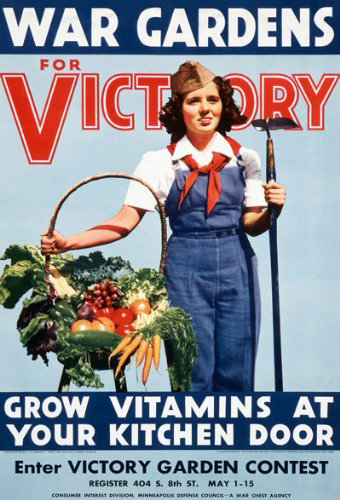
Rationing and Victory Gardens
If you were a child growing up in the Fifties or Sixties, you probably recall hearing something about them.
In his later years, Father would tell The Boy about how commodities such as gasoline, coal, and various types of foods were rationed during World War II, as they had been during World War I. In fact, after Father had been drafted into the army, and before he went overseas, he came back to West Haven for one last visit; and while he was here, he walked to the town rationing board to apply for extra food for his family.
Food was rationed, shoes were rationed, some medicines were in short supply due to naval blockades–the majority of all these articles were reserved for use by the Armed Services.
One day when he was still a child, The Boy’s mother would tell him of all the ways that Americans pulled together to support those who had left home to fight the nation’s enemies during WWII.
One thing that she mentioned was something called “Victory Gardens,” a term which sounded strange to The Boy: How could a garden help America to win a war?
Victory Gardens, also called war gardens, or food gardens for defense, were utilized during WWI and WWII to provide supplemental crops to ease food shortages. In fact, they operated in England, Canada, Australia and the United States, using private and public lands. During WWI, President Wilson encouraged Americans to grow Victory Gardens, saying that, “Food will win the war.”
As a direct result, five million Victory Gardens were in operation in the U.S. by the war’s end. In Canada, ladies’ organizations brought expert gardeners into the schools to get school children and their families interested in gardening. In addition, homeowners were encouraged to keep hens in their yards for egg production.
During WWII–when much of Europe was devastated by the fighting–for many, starvation was near at hand. Even before the U.S. entered the war, we were supporting the British with regular shipments of food. Something had to make up for shortages created by these massive exports, so President Roosevelt appealed for a rebirth of Victory Gardens, and First Lady Eleanor Roosevelt set a national example by creating a Victory Garden on the White House lawn.
By May of 1943, there were 18 million Victory Gardens operating in the United States. This served to unite the home-front and empower the people. The slogan, “grow your own, can your own,” became popular during the war years. Many families continued to tend their backyard gardens and can their fruits and vegetables long after the war had ended.